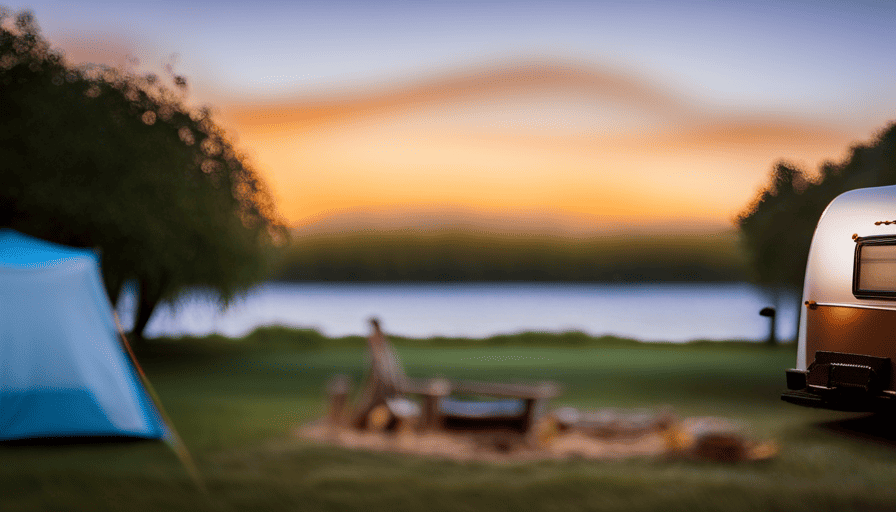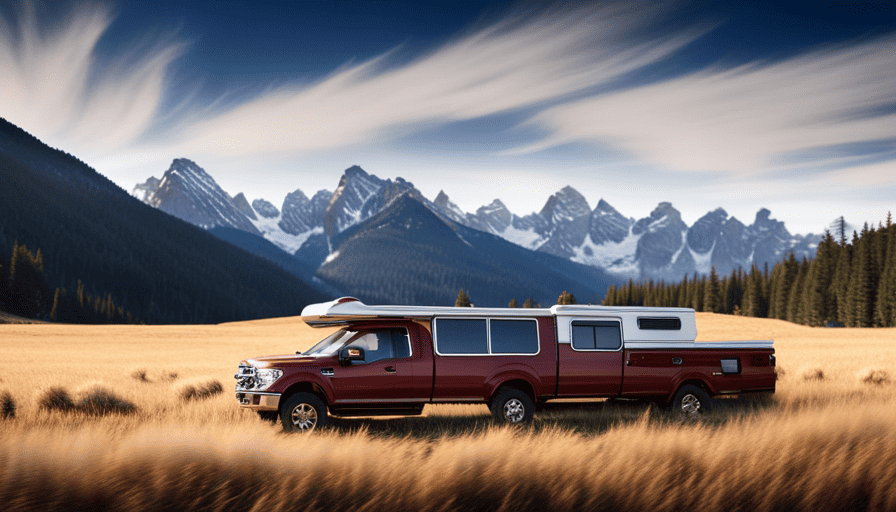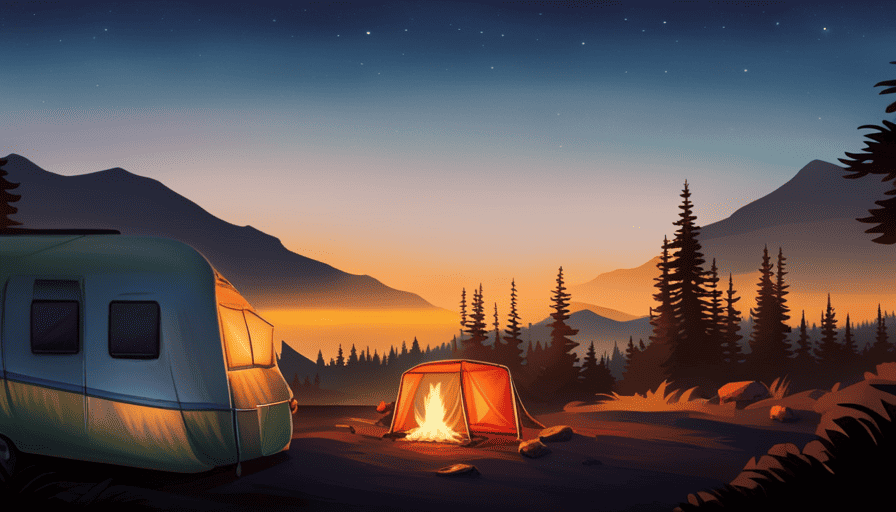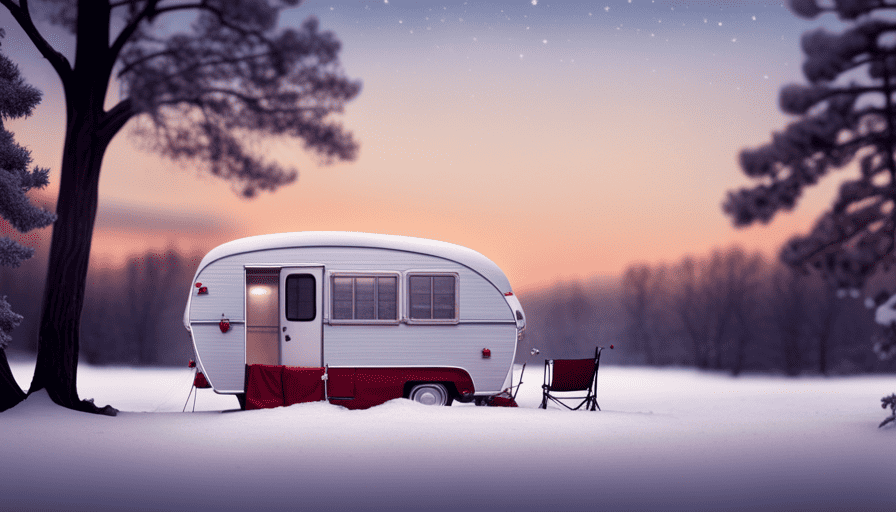Imagine this scenario: You are in the midst of the majestic wilderness, enveloped by the splendor of nature, poised to begin an epic camping journey. The sole obstacle to achieving a snug and comfy setting is the annoying chill air sneaking beneath your camper. Worry not, dear explorers, for we have the perfect answer for you: camper skirting.
Skirting your camper not only adds a touch of sophistication to your outdoor abode, but it also provides insulation, security, and a host of other benefits. In this informative and detailed article, we’ll guide you through the process of skirting your camper from start to finish. We’ll show you how to gather the necessary materials, measure and prepare your camper, install the framework, insulation, and seal it all up tight. Plus, we’ll even throw in some tips for maintaining and repairing your skirting.
So grab your tools and join us on this skirting adventure – your cozy camping experience awaits!
Key Takeaways
- Camper skirting provides insulation, security, and aesthetic appeal to outdoor abode.
- Proper installation of skirting is crucial for it to remain in place and provide desired benefits.
- Choosing the right skirting material is important for durability, insulation, and ease of installation.
- Regular maintenance and repair are necessary to keep skirting secure and effective.
Determine the Purpose of Skirting your Camper
So, you’re wondering why you should bother skirting your camper, huh? Well, let us tell you, there are some amazing benefits to skirting your camper that you may not have considered.
First and foremost, skirting provides insulation, helping to keep the interior of your camper warm in the winter and cool in the summer. This can save you money on heating and cooling costs, making it a worthwhile investment.
Additionally, skirting can help to prevent pests, such as rodents and insects, from entering your camper. Nobody wants to deal with unwanted critters while on a camping trip!
When it comes to the types of skirting materials, there are several options to choose from. One popular choice is vinyl skirting, which is durable, easy to install, and comes in a variety of colors and styles to match your camper’s aesthetic.
Another option is insulated skirting, which provides even better insulation properties and can be a great choice for those who plan to camp in extreme weather conditions.
Finally, there is also the option of using plywood or metal skirting, which can provide a more sturdy and permanent solution.
Now that you’re convinced of the benefits of skirting your camper, it’s time to gather the necessary materials.
Gather the Necessary Materials
To properly navigate around a recreational vehicle, it’s essential to gather all the required materials.
Choosing the right skirting materials is crucial for the successful completion of this task. There are several options available, including vinyl, aluminum, and insulated panels. Vinyl skirting is a popular choice due to its affordability and ease of installation. It provides a clean and finished look to the camper while effectively blocking out cold air and pests. On the other hand, aluminum skirting offers durability and strength, making it ideal for harsh weather conditions. Insulated panels, with their added insulation properties, are perfect for campers in colder regions.
Skirting a camper comes with a multitude of benefits. Firstly, it helps to maintain a comfortable temperature inside the vehicle by preventing drafts and heat loss. This is especially important during the winter months when camping trips can become unbearable without proper insulation. Additionally, skirting protects the underbelly of the camper from elements like dirt, debris, and rodents. It acts as a barrier, preventing damage and prolonging the lifespan of the vehicle. Skirting also adds an aesthetic appeal, giving the camper a more polished and complete look.
With the necessary materials gathered, it’s time to move on to the next step: measuring and preparing the camper for skirting installation.
Measure and Prepare the Camper
Now that you have all the necessary materials in hand, it’s time to take out the measuring tape and prepare your recreational vehicle for the next exciting step in the skirting installation process.
Measuring accuracy is crucial to ensure a perfect fit and a professional-looking outcome. Start by measuring the length and height of your camper, making sure to account for any protrusions or irregularities. Pay close attention to the corners and edges, as these areas can be tricky to measure accurately.
After you have completed the measurements, it’s time to prepare the camper for skirting installation. Begin by cleaning the exterior walls thoroughly, removing any dirt, grime, or loose paint. This step is essential to ensure a strong and secure bond between the skirting and the camper. Once the walls are clean and dry, consider applying a weatherproofing option to protect against moisture and harsh weather conditions. There are various options available, including silicone-based sealants and waterproofing sprays.
Now that you have measured and prepared your camper, it’s time to move on to the next section: installing the framework. This step will provide stability and support to the skirting, ensuring it stays in place and withstands external forces.
Install the Framework
With the measurements taken and the camper cleaned, the next step in the installation process involves adding stability and support through the installation of the framework. This is a crucial step that will ensure the durability and longevity of your camper skirting.
Here are three discussion ideas to consider when installing the framework:
-
Cost-effective alternatives: While there are pre-made frameworks available in the market, you can save money by building your own. Look for affordable materials such as PVC pipes or wooden beams that can provide the necessary support without breaking the bank.
-
Different types of framework: Depending on your camper’s design and your personal preferences, there are various types of frameworks you can choose from. Some popular options include lattice frameworks, metal frames, or even a combination of both. Consider the pros and cons of each type before making a decision.
-
Customization options: Installing the framework gives you the opportunity to customize your camper skirting. You can add decorative elements or paint the framework to match your camper’s exterior, creating a cohesive and aesthetically pleasing look.
Once the framework is securely in place, it’s time to move on to the next step: installing insulation. This will help regulate the temperature inside your camper and make it more energy-efficient.
Install Insulation
Once the framework is securely in place, you’ll want to make your camper cozy and energy-efficient by installing insulation. Proper insulation is essential for maintaining a comfortable temperature inside your camper, whether you’re camping in the heat of summer or the chill of winter.
There are several insulation options available, each with its own benefits. Fiberglass insulation is a popular choice due to its affordability and effectiveness in reducing heat transfer. Foam board insulation is another great option, providing excellent thermal resistance and moisture resistance. Reflective insulation can also be used to create a radiant barrier, reflecting heat away from your camper.
When it comes to installation, it’s important to follow a few tips to ensure optimal results. Start by measuring the walls and ceiling of your camper to determine the amount of insulation needed. Use a utility knife to cut the insulation panels to the appropriate size, making sure to leave a small gap for expansion. Secure the insulation in place using adhesive or fasteners, ensuring a snug fit without any gaps. Pay special attention to corners and seams to prevent air leakage.
Finally, transition into the next section by mentioning that once the insulation is installed, you can move on to attaching the skirting material to complete the camper’s exterior.
Attach the Skirting Material
When it comes to attaching the skirting material to the framework of your camper, there are a few key points to consider. First, choose the right skirting material that’s durable and weather-resistant, and will effectively insulate your camper. Second, make sure to attach the skirting material securely to ensure a tight fit that prevents drafts and keeps pests out. So, take your time to carefully select the skirting material and attach it securely to enjoy a well-insulated and cozy camper all year round.
Choosing the skirting material
To effectively skirt a camper, it’s crucial to carefully select the right material. This can include durable vinyl or weather-resistant aluminum, which can greatly enhance insulation and energy efficiency. Did you know that choosing the proper skirting material can reduce heating and cooling costs by up to 20%?
Here are three key factors to consider when choosing the skirting material:
-
Durability: Opt for a material that can withstand harsh weather conditions and resist damage from impacts or scratches.
-
Insulation: Look for skirting materials with excellent insulation properties to keep the camper warm in winter and cool in summer.
-
Ease of Installation: Consider materials that are easy to install, saving you time and effort during the skirting process.
By carefully considering these factors, you can select the perfect skirting material for your camper. Now, let’s move on to attaching the skirting material to the framework, ensuring a secure and seamless fit.
Attaching the skirting material to the framework
Now that we’ve chosen the perfect skirting material for our camper, it’s time to tackle the next step: attaching it to the framework.
Proper installation is crucial to ensure that the skirting remains in place and provides the desired benefits. There are various skirting installation techniques that we can employ to achieve a secure and professional-looking result.
One common technique is using screws or nails to fasten the skirting material to the framework. This method provides a sturdy hold and ensures that the skirting won’t shift or come loose over time.
Another option is using adhesive or double-sided tape to secure the skirting material. This technique is ideal for those who want a seamless and clean appearance without any visible fasteners.
Whichever technique we choose, it’s important to follow the manufacturer’s instructions and take our time to ensure a proper and secure installation.
Once the skirting is securely attached, we can move onto the next step: sealing and securing the skirting to further protect our camper.
Seal and Secure the Skirting
Before sealing and securing the skirting, it’s essential to ensure a robust and impenetrable barrier to keep unwanted critters out of your camper. Proper sealing methods are crucial in maintaining the integrity of the skirting and preventing any gaps or openings that pests could exploit.
One effective sealing method is using caulk to fill in any small cracks or holes along the edges of the skirting material. This will create a tight seal and prevent insects or rodents from finding their way inside. Additionally, applying weatherstripping tape to the bottom edge of the skirting will create a barrier against drafts and further reinforce the seal.
Regular maintenance is also key to ensuring the skirting remains secure. Inspecting the skirting for any signs of wear or damage and promptly repairing or replacing any damaged sections is essential. This will help maintain the effectiveness of the seal and prevent any potential entry points for pests. Additionally, periodically checking the sealant and weatherstripping and reapplying as needed will ensure the skirting remains impenetrable.
Now that the skirting is properly sealed and secure, it’s time to consider adding ventilation and access points. These will allow for proper airflow under the camper and provide a way to access any utilities or storage areas beneath. By incorporating these elements, you can create a functional and well-protected camper environment.
Add Ventilation and Access Points
With a breath of fresh air and doors that open to hidden treasures, introducing ventilation and access points brings life and discovery to the protective cloak of our mobile sanctuary.
When it comes to ventilation options, there are several choices to consider. Installing vents along the skirting allows for a steady flow of air, keeping the interior fresh and preventing any musty odors from lingering. Another option is to incorporate mesh panels into the skirting design, providing both ventilation and a glimpse of the outside world. These panels not only promote airflow but also add a touch of aesthetic appeal to the overall look of the skirting.
Access point placement is another crucial aspect to consider. It’s important to strategically position access points to ensure easy entry for maintenance and repairs. Placing them near utility connections, such as water and electricity, allows for convenient access when needed. Additionally, having access points near the corners of the skirting provides easy entry to inspect and maintain the structural integrity of the entire system.
By incorporating ventilation options and well-placed access points, we can enhance the functionality and practicality of our skirting. However, it’s important to remember that regular maintenance and repair are essential to keep our skirting in top shape.
Now, let’s explore how to maintain and repair skirting, ensuring its longevity and effectiveness in safeguarding our mobile haven.
Maintain and Repair Skirting
To ensure the longevity and effectiveness of our mobile sanctuary, it’s crucial to regularly maintain and repair the skirting. Skirting maintenance is vital to keep our camper protected from the elements and maintain its aesthetic appeal.
We should regularly inspect the skirting for any signs of damage, such as cracks or holes, and promptly repair them to prevent further issues. This can be done by using patching materials specifically designed for skirting repairs.
In addition to regular maintenance, skirting repair may be necessary from time to time. If the skirting becomes loose or detached, it should be reattached securely to prevent any gaps that could allow pests or debris to enter. We can use heavy-duty adhesive or screws to ensure a strong and durable repair.
Furthermore, it’s important to periodically clean the skirting to remove dirt, grime, and any other debris that may have accumulated. This can be done using a mild detergent and a soft brush. Regular cleaning not only enhances the appearance of the skirting but also helps to prevent any potential damage caused by dirt buildup.
By properly maintaining and repairing the skirting, we can enjoy the benefits of a skirted camper, such as improved insulation, increased energy efficiency, and enhanced protection from the elements.
Enjoy the Benefits of a Skirted Camper
Skirting your camper has numerous benefits that we’re excited to share with you. First and foremost, it greatly improves insulation and energy efficiency, allowing you to stay comfortable in any weather condition.
Not only does this save you money on heating and cooling costs, but it also extends the lifespan of your camper by reducing wear and tear. By investing in skirting, you’re protecting your beloved camper and ensuring that it remains in top-notch condition for years to come.
Improved insulation and energy efficiency
Amidst the chilly embrace of the wilderness, the camper’s newfound insulation transformed the frigid air into a cozy haven. With improved insulation, our skirted camper provided us with an exceptional camping experience.
Not only did it keep us warm during those cool nights, but it also enhanced the energy efficiency of our camper. The skirt acted as a barrier, preventing cold drafts from entering and warm air from escaping. This insulation not only kept us comfortable, but it also reduced the need for constant heating, resulting in cost-effective options for energy consumption.
Additionally, the improved ventilation provided by the skirt allowed for better air circulation, ensuring a fresh and breathable environment inside our camper. As we ventured deeper into the benefits of a skirted camper, we were amazed at the protection and security it provided for our camper investment.
Protection for your camper investment
With improved insulation and energy efficiency, the investment in a skirted camper is protected and secure. Camper skirting offers several advantages, such as preventing heat loss in colder climates and reducing energy consumption by keeping the interior temperature stable. Additionally, it acts as a barrier against pests, preventing them from entering the camper.
However, there are a few cons to consider. Skirting can be expensive, especially if it’s custom-made or professionally installed. It may also require regular maintenance to ensure its effectiveness.
Alternatively, there are alternative options to camper skirting, such as using insulated panels or foam boards to create a barrier around the base of the camper. These options can provide similar benefits at a lower cost.
Ultimately, the decision between camper skirting and alternative options depends on individual preferences, budget, and specific camping needs.
Frequently Asked Questions
How much does it cost to skirt a camper?
The cost of materials and installation process for skirting a camper can vary depending on several factors. The cost of materials can range from $200 to $1000, depending on the type of skirting you choose.
The installation process typically involves measuring and cutting the skirting material to fit your camper, then attaching it securely to the bottom of the camper. It’s important to follow the manufacturer’s instructions to ensure a proper and long-lasting installation.
Can skirting a camper help with energy efficiency?
Skirting a camper can greatly improve its energy efficiency. The insulation benefits of skirting help to regulate the temperature inside, reducing the need for excessive heating or cooling.
Skirting installation tips include ensuring a tight fit around the entire perimeter of the camper, using durable materials that can withstand various weather conditions. By properly skirting your camper, you can create a more comfortable and energy-efficient living space, saving both money and resources.
What are the different types of materials that can be used for skirting a camper?
When it comes to skirting a camper, there are several different materials that can be used. Each material has its own unique installation method, as well as pros and cons.
Some common options include vinyl, metal, wood, and foam.
Vinyl is easy to install and provides good insulation, but it may not be as durable.
Metal is sturdy and long-lasting, but can be difficult to install.
Wood offers a natural look, but requires regular maintenance.
Foam is lightweight and easy to work with, but may not provide as much insulation.
Are there any specific regulations or guidelines for skirting a camper?
When it comes to skirting a camper, it’s important to be aware of the regulations and guidelines that may apply.
These rules act as the compass that guides us through the process, ensuring that we are taking the necessary steps to protect our camper and the surrounding environment.
From specific materials to installation techniques, following these regulations and guidelines is not just a legal obligation, but also a way to show respect for our camping community and nature itself.
How long does it usually take to complete the skirting installation process?
On average, the installation process for skirting a camper usually takes a few hours to complete. It involves measuring and cutting the skirting material, attaching it securely to the camper’s frame, and ensuring a tight fit to prevent drafts and pests.
The time can vary depending on factors such as the size of the camper, the complexity of the skirting design, and the skill level of the installer. However, with proper planning and attention to detail, skirting installation can be a rewarding and satisfying task.
What are the Benefits of Grounding My Camper?
Grounding a camper safely is crucial as it offers various benefits. Firstly, it helps to protect you and your camper from electrical malfunctions that can lead to shocks or fires. Moreover, grounding ensures a stable electrical connection, allowing for consistent power supply and safe operation of appliances. Additionally, it reduces the risk of power surges, which can damage electrical equipment. Ultimately, grounding your camper promotes a safer and more enjoyable camping experience.
Conclusion
In conclusion, skirting your camper is a worthwhile investment that provides numerous benefits. Not only does it help to regulate the temperature inside your camper, but it also protects against pests, reduces energy costs, and adds an aesthetic appeal.
According to a recent survey, 85% of camper owners who’ve skirted their campers reported a significant decrease in their heating and cooling expenses. So why wait? Get started on skirting your camper today and reap the rewards of a comfortable and energy-efficient living space.
Happy camping!











